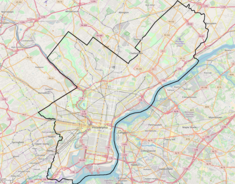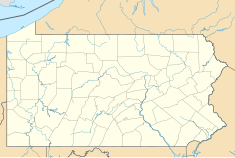
Back Parc Històric Nacional de la Independència Catalan Independence National Historical Park CEB Independence National Historical Park German پارک ملی تاریخی ایندیپندنس (فیلادلفیا) Persian Independence National Historical Park Finnish Parc national historique de l'indépendance French פארק העצמאות ההיסטורי הלאומי HE Parco storico nazionale dell'indipendenza Italian アメリカ独立国立歴史公園 Japanese 독립역사공원 Korean
| Independence National Historical Park | |
|---|---|
 The Liberty Bell (foreground) and Independence Hall (background) at Independence National Historical Park | |
| Location | 143 S. 3rd Street, Philadelphia, Pennsylvania, U.S. |
| Coordinates | 39°56′52″N 75°08′53″W / 39.947778°N 75.148056°W |
| Area | 55.42 acres (22.43 ha)[1] |
| Architect | William Strickland, et al. |
| Architectural style(s) | Colonial, Georgian, and Federal |
| Visitors | 3,572,770 (in 2011) |
| Governing body | National Park Service |
| Website | nps.gov |
| Designated | October 15, 1966 |
| Reference no. | 66000683[2] |
| Designated | June 28, 1948 |
Independence National Historical Park is a federally protected historic district in Philadelphia, Pennsylvania that preserves several sites associated with the American Revolution and the nation's founding history. Administered by the National Park Service, the 55-acre (22 ha)[1] park comprises many of Philadelphia's most-visited historic sites within the Old City and Society Hill neighborhoods. The park has been nicknamed "America's most historic square mile" because of its abundance of historic landmarks.[3][4][5]
The centerpiece of the park is Independence Hall, where the Declaration of Independence and the United States Constitution were debated and adopted by America's Founding Fathers in the late 18th century.[6] Independence Hall was the principal meetinghouse of the Second Continental Congress from 1775 to 1783 and the Constitutional Convention in the summer of 1787.[7] Next to Independence Hall is Carpenters' Hall, the 1774 meeting site for the First Continental Congress, and Congress Hall, the meeting place of the United States Congress in the 1790s prior to the establishment of Washington, D.C. as the nation's capital in 1800.
Across the street from Independence Hall is the Liberty Bell, an iconic symbol of American independence, displayed in the Liberty Bell Center. The park contains other historic buildings, such as the First Bank of the United States, the first bank chartered by the United States Congress, and the Second Bank of the United States, which had its charter renewal vetoed by President Andrew Jackson as part of the Bank War. The Park also contains City Tavern, a recreated colonial tavern, which was a favorite of the delegates and which John Adams felt was the finest tavern in all America.[8][9]
Most of the park's historic structures are located in the vicinity of the four landscaped blocks between Chestnut, Walnut, 2nd, and 6th streets. The park also contains Franklin Court, the site where Benjamin Franklin's home once stood and the present-day location of a Franklin museum and the United States Postal Service Museum (Franklin was the first Postmaster General of the revolutionary government). An additional three blocks directly north of Independence Hall, collectively known as Independence Mall, contain the Liberty Bell Center, National Constitution Center, Independence Visitor Center, and the former site of the President's House. The park also contains other historical artifacts, such as the Syng inkstand which was used during the signings of both the Declaration and the Constitution.
- ^ a b Independence National Historical Park – Business Plan, National Park Service.
- ^ "National Register Information System". National Register of Historic Places. National Park Service. March 13, 2009.
- ^ Vogel, Morris (1991). Cultural connections: museums and libraries of Philadelphia and the Delaware. Temple University Press. p. 202. ISBN 978-0-87722-840-0. Retrieved April 8, 2011.
- ^ Dunbar, Richard (1999). Philadelphia. Casa Editrice Bonechi. p. 10. ISBN 978-88-8029-926-4. Retrieved April 8, 2011.
- ^ Fodor's (2005). Fodor's Philadelphia and the Pennsylvania Dutch Country (3rd ed.). Random House Digital. p. 8. ISBN 1-4000-1567-7. Retrieved April 8, 2011.
- ^ Greiff, Constance M. (1987). Independence: the creation of a national park. Philadelphia: University of Pennsylvania Press. p. 113. ISBN 0-8122-8047-4. Retrieved June 11, 2011.
...and at the park's centerpiece, Independence Hall.
- ^ Independence Hall Archived 2011-05-19 at the Wayback Machine, Historic Philadelphia.
- ^ Staib, Walter. City Tavern Cookbook: 200 Years of Classic Recipes from America's First Gourmet Restaurant, p. 5, Running Press, Philadelphia, London, 1999. ISBN 0-7624-0529-5.
- ^ Staib, Walter. City Tavern Baking & Dessert Cookbook: 200 Years of Authentic American Recipes, pp. 9, 14, Running Press, Philadelphia, London, 2003. ISBN 0-7624-1554-1.


